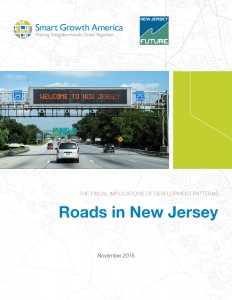Fiscal Implications of Development Patterns: Roads in New Jersey
 In this report, New Jersey Future teamed up with Smart Growth America to examine the relationship between residential and employment density and per-capita road usage, and to consider how much state, county and municipal governments in New Jersey could save on road maintenance bills by building in more compact ways.
In this report, New Jersey Future teamed up with Smart Growth America to examine the relationship between residential and employment density and per-capita road usage, and to consider how much state, county and municipal governments in New Jersey could save on road maintenance bills by building in more compact ways.
The Fiscal Implications of Development Patterns: Roads in New Jersey analyzes the relationship between road infrastructure needs and population and employment density. It found that as density increases, per-capita road needs decrease, suggesting in turn that there are road-maintenance savings to be realized if the distribution of New Jersey’s population and jobs could be made even incrementally more dense and compact.
See full data by municipality
See full data by pavement area per capita
Researchers at Smart Growth America and New Jersey Future took two distinct but related approaches to these questions. Smart Growth America partitioned the whole state into grid cells of equal size and then compiled data for each cell. Using U.S. Census data regarding population and employment, and the New Jersey Department of Transportation’s database of road segments, SGA researchers calculated the relationship between density and road area per capita.
New Jersey Future analyzed road area per capita based on municipalities rather than grid cells, and used population and employment data to calculate “net activity density” for each municipality, defined as population plus employment divided by developed square miles. Municipalities with high net activity densities and low road area per capita are getting the best possible return on their investments, in terms of the number of people served by each acre of pavement. The report includes a list of these municipalities.
The analysis concludes that a) local road needs per capita decrease as activity density increases, and b) the greatest potential per-capita savings in road-maintenance costs can be realized in the lowest-density communities. For example, if a rural community were able to increase its activity density from two people per acre to four, it would see much lower per-capita road usage, suggesting the potential for much greater per-user cost savings, than would a municipality that increased its activity density from 20 to 40 people per acre. Statewide, the report concludes, savings on road maintenance could reach $470 million per year or more through such density increases.
Both analyses make clear the long-term road-infrastructure cost implications of various land-use decisions. Leaders at both the state and municipal levels in New Jersey — and elsewhere — can use these findings to make better-informed decisions about development patterns moving forward.
The report is the latest in Smart Growth America’s series of fiscal-impact analyses. Earlier in 2015, the organization released a new model for analyzing the fiscal implications of development patterns.











